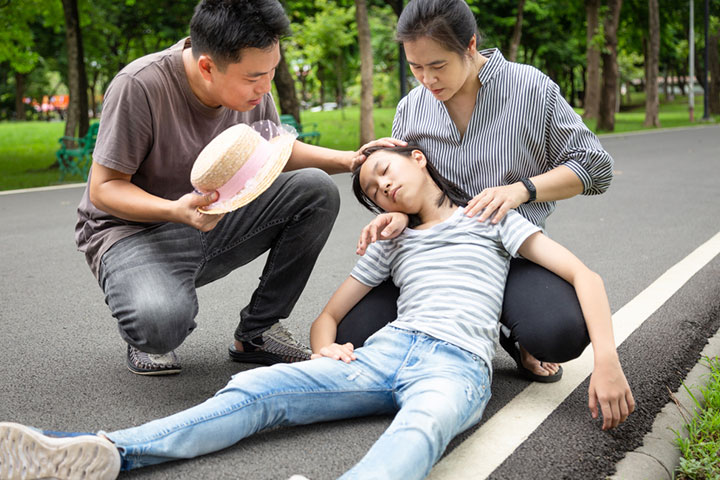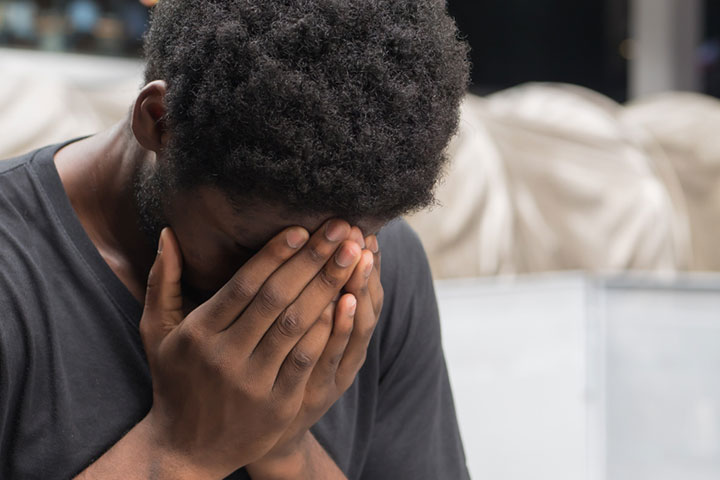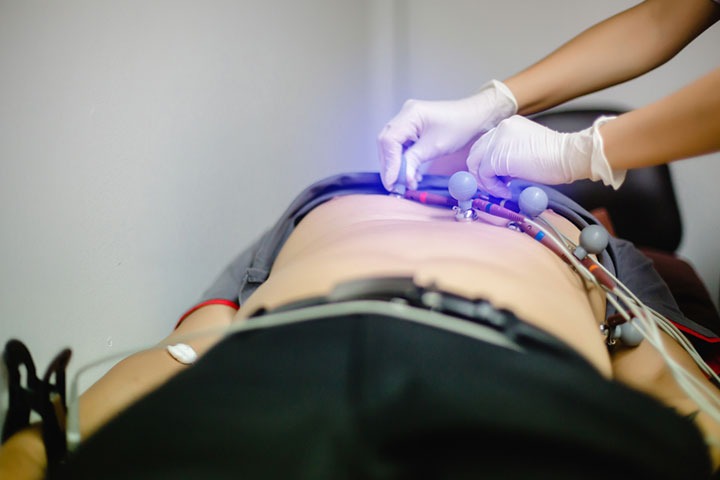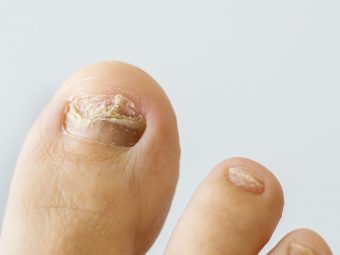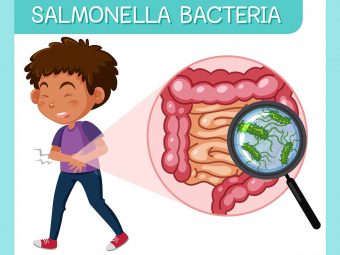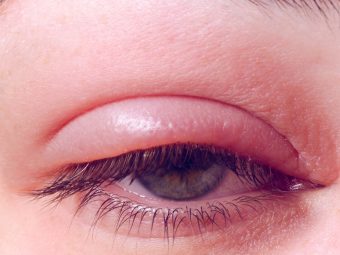
Image: Shutterstock
Lightheadedness and black spots in the vision can be symptoms of low pressure in teens. Periodic drop in blood pressure or low blood pressure in otherwise healthy teens is not a cause of concern. Some may get hypotension while changing body positions, such as standing or sitting from a lying position. However, it is recommended to evaluate frequent hypotension in teens since it can be due to underlying conditions(1).
Read on to know the causes, symptoms, treatment, and preventive measures for hypotension in teens and when to seek medical care for fainting spells.
What Is Low Blood Pressure In Teens?
Image: Shutterstock
Low blood pressure happens when the blood pressure (BP) levels are less than normal.The normal blood pressure for a teenager is around 110/70mmHg(2). (BP is measured in millimeters of mercury denoted as mmHg and features two numbers: one that indicates the upper value (systolic) followed by the lower (diastolic) value.)
In children aged ten years or less, blood pressure lower than 90/50mmHg is defined as low blood pressure or hypotension(3).
Low blood pressure can be categorized into three types, the symptoms of which can range from mild to severe.
- Neurally mediated hypotension (NMH): It occurs when the child stands for a long time or encounters an upsetting or scary situation. Itcauses dizziness. However, children usually outgrow NMH(4).
- Orthostatic hypotension: (Also known as postural hypotension): It occurs while standing up suddenly from a sitting or lying position. It happens when the body is unable to adjust to the sudden change in the blood flow. However, the blood pressure will be back to normal after a few seconds(5). There could be many reasons for this occurrence, including autonomic nervous system dysfunction.
- Severe hypotension: It can develop due to severe infections, allergic reactions, severe blood loss due to an injury, or a circulatory shock.Severe hypotension can cause complications by preventing the blood from reaching the brain, thus making it a life-threatening condition.In such cases, immediate medical attention is necessary(6).
What Are The Symptoms Of Low Blood Pressure In Teenagers?
Image: Shutterstock
Most symptoms of hypotension may be recurrent but don’t usually last for a long time. Watch out for the following symptoms, and consult a doctor if they persist(6):
- Blurred vision or black out
- Light-headedness
- Confusion
- Dizziness
- Fainting
- Feeling weak
- Nauseaor vomiting
- Sleepiness
There could be various reasons for low blood pressure in teens.
What Causes Low Blood Pressure In Teens?
A drop in the blood pressure level could be due to several factors. Underlying health issues or the lifestyle can be a reason.
Common causes include:
Image: Shutterstock
- Low intake of salts and fluids
- Emotional stress
- Standing in an upright posture for a long time and in a warm environment like a hot bath(7)
- Severeiron deficiency anemia(8)
- Drinking alcohol (teenagers)(9)
- Prolonged bed rest (orthostatic hypotension)(10)
Dr. Madalina Petrescu, a cardiologist from Seattle, Washington, says, “Stress can play a significant role in the teenage years. Therefore, teens should engage in relaxing and de-stressing techniques, such as exercise, going out in nature, journaling, coloring, and meditation. If the emotional stress is significant, I recommend seeing a therapist to share and express feelings. Not expressing or talking out emotions can increase the overall risk of more stress.”
If your child’s doctor diagnoses hypotension due to the factors mentioned above, then it may be addressed with certain lifestyle changes.
However, there are a fewuncommon causes for hypotension in children, which might indicate an underlying medical condition.
- Hypovolemia (low blood volume in the body) due to excess use ofdiureticsiXAlso known as water pills, they help remove salt and water from the body,vasodilatorsiX药物,使血液动脉扩张,impacting the muscles that line the arteries and veins limiting tightness of the walls)
- Addison’s disease (a condition where adrenal glands do not produce enough hormones)
- Diabetes
- Sudden loss of blood
- Severe infection
- Allergic reaction(anaphylaxis)
- Heart diseases, such as heart failure, bradycardia, and changes in heart rhythm(6)
 Quick fact
Quick factLow Blood Pressure In A Teenage Girl
Sometimes, teenage girls tend to have hypotension and episodes of unconsciousness during menstruation. This could be triggered due to pain or heavy bleeding during menstruation, or due to vasovagal syncope.
Vasovagal syncope (VVS) is a reflex disorder that leads to transient loss of consciousness.This is characterized by symptoms, such as acute visual disturbance, auditory disturbance, cognitive slowing, followed by hypotension with lightheadedness and loss of consciousness. However, studies found that the severity of lightheadedness changes during the menstrual cycle and was found to be similar in both VVS patients and healthy individuals.
Also, VVS patients were not found to have any greater risk of gynecological abnormalities andpregnancy complicationswhen compared to otherwise healthy individuals.(11).
A few changes in lifestyle, such as taking adequate fluids and salts plus moderate exercise, can help manage this condition.However, if your teenager is having frequent episodes of lightheadedness during her periods, then it is best to schedule an appointment with a gynecologist.
Observe the symptoms to know if everything is alright with the child. The next section talks about diagnostic methods for low blood pressure in children.
How Is It Diagnosed?
Image: Shutterstock
The doctor will begin the diagnosis by checking the teen’s medical and family health history. This is followed by a physical examination and a few tests, including cardiac examinations.
- Auscultation method: It is the preferred method for checkingblood pressure, wherein the sound from the heart is heard using a stethoscope. It requires a cuff that fits the child’s upper arm(12).
- Blood tests: If anemia is suspected to be the reason for low blood pressure in the child, then a blood test like hemoglobin is done. Low blood sugar could also cause hypotension, which can be evaluated through the blood test.
- Electrocardiography: It is a standard health screening tool used for evaluating the cardiovascular health of children and adolescents. The high or low pulse rate (or heart rate) and the rhythm are evaluated through this diagnostic approach, which is typically used in the diagnosis of syncope that benign NMH can cause(13).
- Tilt table test: If a child complains of dizziness for unknown reasons, then this test is done. During the test, the child has to lie on a table that tilts from a horizontal to a vertical or upright position. The doctor checks the child’s reaction when the table is tilted, to diagnose orthostatic hypotension(14)(15).
Based on the diagnosis, your doctor will suggest the appropriate treatment for hypotension.
Treatment For Low Blood Pressure
Low blood pressure is associated with mild symptoms and rarely requires any treatment. If hypotension is due to the medication that your child has been taking for any other health problem, then the doctor may change the medication, lower its dosage, or advice to stop using it.
If your child is diagnosed with NMH, then the doctor suggests changes to their lifestyle and advises you to provide adequate fluids, salt, and nutritional foods. If that doesn’t work, then medication is recommended. Pediatric patients with NMH rarely might be given drugs likebeta-blockersiXDrugs that lower blood pressure, also known as beta-adrenergic blocking compoundsandfludrocortisoneiXA type of steroid used to regulate the quantity of salt and water in the body. However, these both have shown mixed results in pediatric patients, hence caution is needed(13).
How To Prevent Low Blood Pressure In Teenagers?
Image: Shutterstock
If the child has mild symptoms of low blood pressure, then minor changes in the lifestyle might be enough to prevent any problems. Here are a few measures you may consider.
- Avoid dehydration – encourage them to take a lot of fluids.
- Use adequate salt in the diet.
- Make them eat a balanced diet to provide all the essential nutrients to the body.
 Quick fact
Quick fact- Tell them to avoid standing up suddenly from a sitting position.
- Let them eat smaller meals at regular intervals and cut down on the intake of carbohydrates.
- Ask them to wear compression stockings.
- If they have light-headedness or dizziness., let them lie down for a few minutes. with both feet at a higher level than the body.
- Sitting down and putting the head between the knees will help get the blood pressure back to normal.
一个适当的饮食,连同上面的提示,可以帮助你manage low blood pressure better.
 Research finds
Research findsDiet For Low Blood Pressure In Teens
Sometimes, blood pressure drops due to the poor supply of essential nutrients in the body. A balanced diet can help replenish these nutrients and elevate the blood pressure level.
- Includevitamin B12-rich foodssuch as eggs and fortified cereals as they help prevent anemia. Eat egg in boiled or scrambled form.
- Foods such as asparagus and broccoli that are rich in folic acid also help in keeping anemia at bay(16).
- Teenage girls should takeiron-rich foodslike green leafy vegetables, beans, and lentils to compensate for the blood loss during menstruation.
Frequently Asked Questions
1. Does low blood pressure mean dehydration in teens?
Low blood pressure does not mean dehydration. Dehydration is one of the potential factors that can result in low blood pressure in children (17).
2. What neurological disorders cause low blood pressure in teens?
Possible neurological conditions that can cause low blood pressure in teens include (18):
- Orthostatic hypotension is a feeling of dizziness or lightheadedness when a person stands up suddenly. This is caused due to the decrease in the blood supply to the brain.
- Postprandial hypotension is the drop in blood pressure after a meal caused by the changes in the pressure when digesting food.
Afferent baroreflex failure is an instability in the blood pressure due to damage to the nerves that sense the blood pressure. - Familial dysautonomiais a rare inherited condition that causes the blood pressure to fluctuate between too high and too low.
低血压可能发生在青少年由于贫穷lifestyle choices or other underlying medical conditions. In teenage girls, heavy menstrual flow can also lead to low blood pressure. Low blood pressure in teens rarely needs medical attention if there is no major underlying condition. Lifestyle changes, a better diet, physical activities, and medications when needed will help you manage low blood pressure in your teen. Keep monitoring your teen’s blood pressure and if you notice any sudden changes or unusual symptoms, report it to their healthcare provider.
Infographic: What To Do If A Teen Faints Due To Hypotension?
Fainting or syncope is common when the blood pressure is low. It can be said as a nervous system response after sensing low blood pressure in the blood vessels. Go through the infographic to know what to do when a teen faints due to hypotension.

Illustration: Momjunction Design Team
Get high-quality PDF version by clicking below.
Download Infographic
Key Pointers
- Hypotension is indicated by blood pressure measurements that are lower than normal.
- Factors that might cause low blood pressure in teens include malnutrition, dehydration, and some medications.
- Symptoms of hypotension include fatigue, confusion, and dizziness.
- Hypotension can be diagnosed through blood pressure readings and physical examinations.
- Treatment for low blood pressure includes consuming a healthy diet, avoiding certain medications, and staying hydrated.
References:
2.High Blood Pressure in Children and Adolescents; Stanford Children’s Health
3. Ashish Banker, Cynthia Bell, et al.;Blood pressure percentile charts to identify high or low blood pressure in children; NCBI
4. Munir Zaqqa,and Ali Massumi,Neurally Mediated Syncope; NCBI(200)
5. Julian M. Stewart, et al.;Pediatric Disorders of Orthostatic Intolerance; Pediatric Publications
6.Low blood pressure; Medline Plus; US National Library of Medicine
7.Patient Information Brochure on Neurally Mediated Hypotension and Its Treatment; New Jersey ME/CFS Association, INC
8. Jelena Roganović and Ksenija Starinac;Iron Deficiency Anemia in Children; Intechopen
9. Lorena Siqueira, MD and Vincent C. Smith;Binge Drinking; American Academy of Pediatrics
10.Orthostatic Hypotension; Disorder Directory Child Neurology Foundation
11. Prasuna Muppa, et al.;妇科和月经紊乱在女性智慧h Vasovagal Syncope; NCBI(2013)
12. Gbenga Ogedegbe, and Thomas Pickering;Principles and techniques of blood pressure measurement; NCBI(2010)
13. Jeffrey B. Anderson M, et al.;The Evaluation and Management of Pediatric Syncope; Pediatric Neurology
14.Tilt-Table Test; American Heart Association, Inc
15.Evaluation and Management of Orthostatic Hypotension; American Academy of Family Physicians
16.Vitamin B12 and Folate Deficiencies; American Association for Clinical Chemistry
17.Low Blood Pressure (Hypotension) in Children; Nicklaus Children’s Hospital
18.Types of Autonomic Disorders; NYU Langone Health




